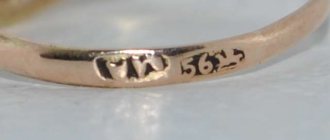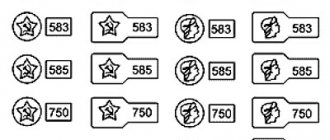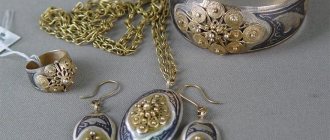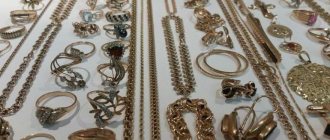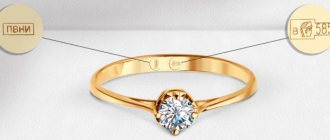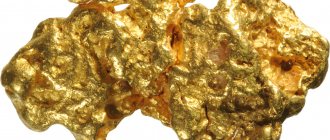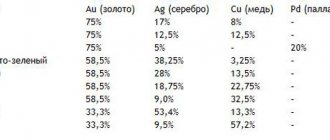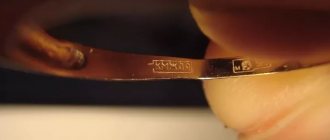Today, many types of jewelry are produced from alloys with different compositions. They differ in sample. Modern options: 375, 500, 585, etc. Among them, the option that complied with the USSR standard - 583 gold standard - is no longer mentioned. Despite the gradual transition to other types of products, many still have jewelry from those times.
Such jewelry has its advantages and disadvantages. But the transition from the most common standard in the post-Soviet countries (583) to European standards for determining quality (585) was associated not with the characteristics of the precious metal, but with a change in the structure of the state, which required transformations in all areas, including jewelry.
What kind of sample is this
Alloys are used to make jewelry.
Their value is determined by the quantitative ratio of pure gold to the remaining components (ligature) and is expressed in the sample, which is applied to the finished product by branding. In 1927, in connection with the transition of the sampling system from spool (as in Tsarist Russia) to metric, sample 583 was approved. In recalculation, it corresponds to the previous value of 56 spools. A stamp with the number 583 indicates that in one kilogram of this alloy there are 583 grams - gold in chemically pure form.
Why was the 583 sample replaced with 585
After the collapse of the USSR, in connection with the entry of a new country into world markets, it became necessary to bring the quality of goods into line with international standards. The international community refused to recognize 583 gold, since when converted from the metric to the carat system, the final value is 13.9 carats instead of the required 14.
In addition, the permissible deviation from the norm (remedium) is +/- 0.3%. This meant that the chemically pure gold content could range from 586 to 580 grams per kilogram. Therefore, in accordance with market requirements, a new standard was established in 1994 - 585 alloy.
Main differences
Experts say that the difference between 583 and 585 samples is not significant. To understand how one hallmark differs from another, you need to go back to the history of the 585 hallmark.
In post-revolutionary Russia, a decision was made to use the metric system for determining the proportion of gold in the alloy. It was radically different from the carat one accepted throughout the world. Soviet experts believed that 583 gold would not differ from world standards of 14 carats. The alloy contained 58.3% pure metal. The remaining share accounted for various impurities, most often played by:
- copper;
- palladium;
- silver.
It was the addition of copper that gave Soviet-era gold its reddish hue. In addition, the impurities made this alloy extremely durable, allowing the jewelry to retain its original shape for many years.
However, the comparison of Soviet gold with 14-karat alloys turned out to be untenable. The standards approved in Western countries for the 14-carat alloy provided for an increased content of pure metal. Such a discrepancy resulted in the USSR being unable to export jewelry to the world market, although Soviet gold was superior to Western gold in many respects, differing:
- high wear resistance;
- strength;
- resistance to mechanical stress.
Properties
In the industrial production of the 583 alloy, a three-component composition with high strength, ductility and ease of use was used, including 33.5% copper and 8% silver. It was the high copper content that gave the metal a noble color with a distinct red tint - such gold was called red gold by analogy with the royal chervonets, which were minted from an alloy of gold and copper and had a similar color.
Strength
Using chemically pure precious metal to make jewelry is impractical, as it is too soft a material. Any thing made of 999 gold will very quickly lose its attractiveness and shine.
In the form of an alloy, gold has much greater strength and resistance to deformation and wear. With proper care, such a piece of jewelry can be passed down from generation to generation as a family heirloom without losing its presentability.
Reasons for mistrust
During the 90s, Turkish-made jewelry gained dominance on the Russian gold market. All of them were marked with the hallmark 585, but most of them were made of very low quality alloys, unable to withstand not only external influences, but also long-term wear.
During the time of the USSR, jewelry lovers became fed up with gold of the traditional reddish hue, so they began to buy rings and chains made of yellow and white metals with great pleasure. However, having received low-quality goods from Turkish jewelers, Russians for many years acquired distrust not only of the 585 marking, but also, in general, of high-quality yellow and white alloys.
The situation changed after the introduction in 2000 of a ban on the import of low-grade foreign-made gold into Russia. Today, domestic jewelers offer customers only the highest quality products made from yellow, red and white alloys of various grades. All decorations are made from materials that comply with state standards approved in the country.
True, manufacturers have the right to independently determine the composition of the master alloy, that is, the qualitative and quantitative composition of impurities. The color of the metal may depend on this, but its fineness will remain unchanged.
Alloy shades
Depending on the composition, five hundred eighty-third has shades from bright red to green. More copper gave a red color, more silver and nickel - white. Gold with a reddish tint was the most popular. Another name is red.
Colors
Copper and silver in the gold alloy help give the products strength. Each metal included in the composition is of different quality, density, and structure. The color of the jewelry being made greatly depends on these characteristics. They can have a black, red, white, greenish tint. In total, 14 shades of 583 gold are known.
Interestingly, there is blue and even black gold in the world. However, the recipes for obtaining it are not disclosed.
Russia today is famous for its white gold. It contains 58.5% pure gold, as well as nickel and palladium. An increase in the composition of the nickel alloy allows you to obtain a delicate light yellow tint of the material. According to the standard, gold is 583 and its color may vary within acceptable limits.
Alloy shade chart
| Color | Ligature, % | Notes |
| Reddish | Silver – 8 Copper – 33.5 | Red gold |
| Pink | Silver – 9 Copper – 32 | |
| Yellow | Silver – 18.7 Copper – 22.7 | |
| Citric | Silver – 30 Copper – 11.5 | |
| White | Silver – 10 Copper – 3 Nickel – 25 Zinc – 3.5 | Mainly used as inserts in products with stones |
Appearance and features of the brand
The appearance of jewelry is influenced by the chemical composition, that is, the percentage of precious metal and ligature. Jewelry item 583 mainly has a characteristic reddish tint. Jewelry with the 585 mark is mainly yellow in color, however, there are various color shades on sale: white, pink, green.
Initially, stamp 583 depicted the head and hammer of a worker and the sample number. Later, in 1958, the print depicted a star, sickle and hammer. On modern jewelry models of article number 585, the imprint depicts the profile of a woman’s face in a headdress.
How many carats are in this sample?
Any sampling system shows how many parts of a chemically pure metal the alloy contains; the only difference is in the units of measurement - kilogram, pound or carat. You can convert the sample value from the metric system to carat or spool using a conversion table.
| Zolotnikovaya | Carat | Metric |
| 96 | 24 | 999,9 |
| 92 | 23 | 958 |
| 91 | Not applicable | 947 |
| 88 | 22 | 916 |
| 84 | 21 | 875 |
| 72 | 18 | 750 |
| 56 | 13,9 | 583 |
| — | 14 | 585 |
| 48 | 12 | 500 |
| 36 | 9 | 375 |
Soviet gold alloy colors
The difference between metals of the same category (583 gold) is significant, and it lies mainly in shades:
| Gold Alloy Color | Ligature content,% |
| Yellow | Cu 33.7 + Ag 8 |
| Green | Cu 11.7 + Ag 30 |
| Red | Cu 41.7 |
| Pink | Cu 32 + Ag 9.7 |
| Pink-yellow | Cu 22.7 + Ag 19 |
| Citric | Cu 11.5 + Ag 30.2 |
| White | Cu 3 + Ag 11 + Ni 25 + Zn 2.7 |
The amount of gold in the table is the same for each case – 58.3%.
Gold rings 583 samples
Soviet jewelry art versus modern jewelry: which is better?
Disputes among jewelry lovers about which gold standard is better, 583 or 585, continue to this day. Nostalgic citizens not only of our country, but also of neighboring countries, longingly remember the times when gold jewelry could be easily purchased without worrying about its quality. With the collapse of the Soviet Union, the standard for gold jewelry disappeared, giving way to the 585 standard accepted throughout the world.
Differences in GOST standards and quality
The models were produced according to established standards. This meant exact compliance with GOST standards in terms of composition percentage, melting characteristics and product durability. Jewelry with 583 hallmarks had massive dimensions, strength of composition and high performance properties.
Brand with a star, what it looks like, history of origin, what it means
Today, 583 gold is not used for mass production of jewelry, otherwise the corresponding sample could be found on it. Its main distinguishing mark is the star-shaped mark. Previously (until 1958) they used a different marking - the head of a worker with a hammer. The sample changed, after which it quickly became recognizable.
This is a star containing a hammer and sickle, which means it belongs to the Soviet Union, since inside the sample there are the main elements of the coat of arms.
At the same time, the designation of the assay office has also changed. Cyrillic letters began to appear on jewelry of those times.
The history of gold 583
Everyone knows that the young Soviet state tried to open new paths for its development, as well as to protect itself as much as possible from various foreign standards. This also affected the standard of gold, because the karat system was used throughout the world. It was decided to abandon the usual name.
In Europe, pure gold was one thousandth fine, which was equal to 24 carats, and the alloy that was used to make jewelry had a value of 14 carats.
In the Soviet Union, they carried out a simple mathematical calculation: 14 was divided by 24, and then multiplied by 1000. The result was not a whole number - 583.333, which was rounded down.
The alloy itself received a peculiar nickname “Soviet gold”. In addition, this sample began to mean that the proportion of pure gold in the precious metal was 58%, which could vary up to 58.6%.
Why did sample 583 disappear?
The reason was the failure of the state’s export policy to sell gold products abroad. Jewelry made in the Union sold poorly on the foreign market because it did not meet local standards. Formally, the share of precious metal in European gold models was slightly higher than in the domestic product. This led to the fact that the composition of the alloy was revised, the proportion of pure metal was increased, and the mark was renamed to 585.
Level of quality
The quality of the gold alloy from which the product you like is made allows you to determine the hallmark. Its number reflects the content of pure gold in the alloy. Of course, a 750-karat item is considered more valuable due to the high proportion of noble metal in it, but such jewelry can be too expensive.
585 standard products are traditionally very popular among Russians. This alloy contains almost 60% pure metal and is affordable for a wide range of buyers.
583 gold standard appeared on the Russian jewelry market relatively recently. From 1927 to 1995, buyers of then-Soviet stores could only purchase products made from 583-carat gold. Today, alloys of this quality are practically not used by Russian jewelers. Such jewelry can only be found in the boxes of mothers and grandmothers or on the shelves of antique stores. How do these two indicators differ from each other?
Comparison with 585 sample
As for yellow gold, the best standard today is 585. It does not differ significantly from 583. In terms of the content of pure Au metal in the precious alloy 583, it is 0.2% less than in the alloy 585. It would seem that this is an insignificant detail, but it nevertheless affected the price - it became higher. Jewelry alloys of 583 karat are considered low-grade, and this opinion also appeared due to the fact that unscrupulous jewelers often, under the guise of 583 gold, made an alloy of 580 karat, where the Au content was even lower, appropriating part of the precious metal donated by the customer for themselves .
If you look at the appearance of jewelry made from 583 and 585 samples of gold alloy, a very small number of people can visually distinguish which alloy is which, and then only on the condition that the alloy contains impurities of the same composition. Thus, it is the percentage of pure gold that makes the difference between 583 and 585 samples.
To summarize, we note that the main distinguishing features of products with 583 hallmarks from jewelry made from a precious alloy of 585 hallmarks are:
- the percentage of pure gold in the 583 alloy is 0.2% lower;
- jewelry of 583 standard has a pronounced reddish or pink tint;
- the cost of 1 gram of 583 gold is lower than that of 585 gold;
- in modern industry, products made from 583 alloys are no longer produced.
In addition, jewelry produced in the Soviet era from 583 gold was most often made massive and unpretentious; unique models were rare, and they were not available to the mass consumer; most often, they were stamped jewelry of the same type.
Some pre-revolutionary jewelry possessed sophistication, but it has now become unlikely to acquire them - they are in private collections or handed down in families as family jewelry.
Nowadays, modern jewelers do not chase the weight of the product, but pay the greatest attention to the uniqueness of artistic execution - this is the only way to win consumer loyalty and sell gold jewelry in the face of a huge amount of competition in this area.
Popular products from the Soviet era
Previously, and also now, some of the USSR jewelry is more in demand, although it belongs to the category of rare items:
- classic ring with pearl;
- "Marquise" ring (contains a precious stone);
- “tulip” - can be purchased inexpensively, but you should be careful; under the guise of gold, this product may be a fake (an alloy that does not contain precious metals);
- “samovarchiki”, “kalachi” - popular names for decorations that were previously widespread;
- pendants according to zodiac signs.
How sample 583 was transformed into sample 585
The 583 gold produced in the USSR fell 0.01% short of the 14-karat standard (many countries still use the karat system rather than the metric system) and therefore were not quoted in the West. Traditionally, in the Old World, preference was always given to gold in the following shades:
- white;
- yellow.
And in the USSR, alloys with a reddish tint were more valued. And this Soviet gold was considered vulgar and tasteless in many European countries, and sold poorly. In general, in order to correct this situation, they decided to change the sample slightly - at least this is the official reason.
Although it must be admitted that the technical characteristics of products made from 583 gold were no worse, and sometimes even better. It is not without reason that for many years the described sample 583 had the status of the most reliable and wear-resistant in the Union.
Difference between different purity grades
According to the European system of grading carat purity, both varieties correspond to 14 carats. Purity graduation is the permissible deviation of the noble metal in the volume of alloys. For 583 varieties, the deviation is within 3%, both positive and negative. For article 585, the metal volume deviation can be up to plus 5%. Sometimes there is a mention of the 595 grade, which is a technical preparation of the 585 marking.
Appearance of a new sample
To take a worthy place in the global gold and foreign exchange market after the collapse of the USSR, Russian jewelers developed and approved a new 585 standard, which fully complied with the Western measurement system. At the same time, the old one - 583, was abolished.
The differences between these two alloys are expressed in the fact that the 585 sample contains 0.2% more pure metal than its predecessor, which adds the missing 0.01 carats to 14 units. Thus, the percentage of pure gold in 583 samples is about 59, and in 585 it can reach 62.
| Percentage of gold content in the alloy | Measuring system | ||
| Metric | Zolotnikovaya | Carat | |
| 37,5 | 375 | 36 | 9 |
| 50 | 500 | 48 | 12 |
| (58,3) 58,5 | (583) 585 | 56 | 14 |
| 75 | 750 | 72 | 18 |
| 95,8 | 958 | 92 | 23 |
However, despite the high gold content in the alloy, there is no basis for the assertion that 585 is unconditionally better and more valuable than 583.
In jewelry there is such a thing as remedium. It regulates the permissible error in the content of noble metal in the alloy, that is, its deviation from the norm by several units.
As a rule, the more impurities an alloy contains, the higher the remedium can be. Usually this indicator does not exceed 3 units, but in alloys containing nickel it can reach 5 units. Experts say that such deviations are insignificant and can be ignored. And for the buyer, this means that 583 is just as good as 585.
Gold samples Characteristic differences and features
Gold in everyday life is found in the form of various alloys with a ligature. It is an admixture of precious or base metals that gives gold different shades and qualities. Soft pure gold, thanks to impurities, becomes hard, durable and wear-resistant.
Since ancient times, gold has been mixed with silver and copper. And now they are complemented by other elements: palladium, nickel, platinum, etc. The purity of gold cannot be assessed by eye. It is determined by the content of the alloy in the alloy and its percentage.
583 sample
In the first years of Soviet Power after 1927, the mark 583 was used (see photo below). This is the gold standard of the Soviet Union. Most of the rings and earrings we inherited from our parents are of this quality. In the post-war period, 14-karat gold was widely used in Europe. If 14 is divided by 24 and multiplied by 1000, the result is 583. A large number of wedding rings, jewelry with diamonds, rubies, sapphires and semi-precious stones are made from this alloy. In 2000, the 585 mark became the Russian standard.
500 sample
If the content of yellow metal and alloy is equal, the sample becomes equal to 500. For industrial purposes, this standard is not used, but in production by private craftsmen this high-quality alloy composition is used. Jewelry made from it with an original design or with a special theme receives the opportunity to be fully appreciated. Abroad, brooches, cufflinks, and cigarette cases are made from 500-quality alloy.
Turkish influence
In the 90s of the last century, the Russian market was literally flooded with cheap Turkish jewelry. In fact, these jewelry were made of gold foil, and literally crumbled at the slightest careless movement. All goods imported from Turkey had the 585 hallmark, and people who were accustomed to the durability and reliability of jewelry with 583 gold had negative associations with the new hallmark. At the beginning of 2000, a ban on the import of gold jewelry from Turkey came into force, and consumers of domestic goods were able to see that the new standard was in no way inferior to the Soviet one in quality.
It is difficult to say unambiguously how 585 gold samples differ from 583, provided that their technical characteristics are almost the same. The opinion that old gold does not tarnish compared to new gold is erroneous - this is influenced by the alloy, operating conditions, and other factors.
Scope of application of this alloy
Due to its properties - strength, ductility, easy soldering, scratch resistance, this gold alloy has found wide application in the manufacture of jewelry intended for everyday use. Our grandmothers still wear, without removing, their favorite pendants, earrings or wedding rings, which are decorated with a sample with a star.
Areas of use
The main value and applicability of gold is in its international monetary equivalent. Soviet gold and 583-karat alloys have a pronounced reflectivity; they are ideal conductors of thermal and electrical energy. The metal is highly polished with a high degree of ductility. It is used to make contacts and fuses for important electronic devices. The main consumer of gold is the electrical industry, which uses several hundred tons of material annually.
Gold plates cover the mirrors of electronic telescopes used to study galaxies, the domes of Orthodox churches, and the frames of icons. It is used to produce particularly precise instruments for medicine. Colloidal gold is added during glass production. Gold and alloys are widely used for gilding surfaces and dentures.
The most popular products made of 583 gold among the people are gold jewelry. This category includes: chains, pendants, earrings, brooches, rings, rings, tiaras, bracelets, watches, cigarette cases, cigarette holders, pince-nez, glasses, cufflinks, hairpins. Jewelers often make to special orders: pens, elements for canes, figurines, smoking pipes, writing instruments.
Question-answer section
Is Soviet gold going dark?
Expert opinion
Pribrezhny Gennady Valentinovich
Jeweler 6th category
Changes in the color of gold alloy are normal, due to the presence of chemical active components in the composition. But the conditions under which this happens are different. Soviet jewelry changes color, but products made from alloy 583 change color less often than others.
Where do the stains on your fingers come from?
Expert opinion
Grishanov Mikhail Petrovich
Jeweler, director of the Grishanov and Co. workshop
Darkening of the skin is a consequence of the interaction of substances in the metal composition with a cosmetic product. In addition, a similar effect is achieved when the product is contaminated with polishing material (for example, immediately after purchase).
Signs about the stripe on the cheek
Expert opinion
Pribrezhny Gennady Valentinovich
Jeweler 6th category
The most famous sign is associated with the blush on the cheeks. It is believed that others are gossiping and discussing. You can check if this is true by running a gold ring across your cheek. A dark streak will remain - gossip behind your back, and a light streak will appear - the good intentions of others.
Is it possible to buy 583 samples today?
Many lovers of luxury jewelry today remain faithful to the gold of Soviet times, persistently searching for old items for their collections. Sometimes antique stores offer for sale similar jewelry made of gold marked 583, but their price can be many times higher than the cost of modern products, despite the minimal difference in the percentage of 583 gold from 585.
Secrets of choice
When planning the purchase of an expensive product, you should take into account some features of the choice. Do not think that only the hallmark is the key to quality for many years. When choosing, experts advise adhering to the following rules:
- You can safely purchase simple-shaped jewelry from gold of any standard, focusing on your financial capabilities and taste.
- When buying chains, rings and bracelets containing openwork elements and various weaves, it is better to give preference to metals with the following purity: from 585 to 375. Such alloys are endowed with high strength due to the admixtures of non-ferrous metals, which allows the products not to be afraid of deformation and maintain their original appearance for a long time. many years of wear.
The debate about which sample is better: 583 or 585 has not ceased over the past decades. Nostalgic Russians are sure that only the gold of Soviet times can be considered real. However, experts say that the difference between these alloys is so insignificant that it can easily be neglected.
Modern products with the 585 mark are in no way inferior to the “old” ones either in strength or quality of wear. Manufacturing technology makes it possible to give them not only a fashionable yellow or white color, but also to create alloys of a traditional red hue.
Which type of decoration is best to choose?
Comparison of articles indicates minor differences in their characteristics. And there will be no choice when purchasing a new product, since the old sample is no longer produced.
Is it possible to buy 583 samples today?
Jewelry with the 583 imprint can only be found in antique shops or pawn shops. Also, old models are bought at thematic exhibitions dedicated to the Soviet past.
Secrets of choice
Making a successful purchase of a gold item is not so difficult. The following must be taken into account:
- Weight;
- Precious metal content;
- Design;
- Physical state.
The cost of gold 583 samples
Based on the cost of pure gold, which today is approximately 2500-2700 rubles per 1 gram, the price of 1 gram of 583-carat alloy is 1400-1500 rubles. As for the cost of jewelry made of 583 gold, its cost can be approximately calculated by multiplying the price of gold of this standard by 1.5-2, that is, taking into account the cost of the jeweler’s work. However, some intricate handmade jewelry can cost much more. In other words, 583 gold in the finished product will cost from 2200 to 3000 rubles for each gram of weight.
What does the price consist of?
The price of gold, like any other product, is determined by the ratio of supply and demand. The higher the demand, the more expensive it is; the more supply, the cheaper. If it comes to jewelry, then you will be offered to buy the item at the price of scrap: in this case, the content of pure gold in the product in grams is calculated and the market purchase rate is used.
Reviews
Anastasia:
I got very beautiful earrings from my grandmother, I often receive compliments, several times they offered to sell them for a good price, and no one ever asked about the sample.
Vladimir:
I was selling two chains, which to me were absolutely identical in both appearance and weight. The buyer paid two hundred rubles less for one and said sample 583 was cheaper.
Olga:
I wanted to sell a ring, massive, pre-war work. Mother said that the ring contains a stone of very high quality, a young ruby. I wanted to sell it to an antique dealer, but he considered it scrap, and even cheaper than the market value for the sample, and didn’t even mention the stone.
Price for 1 gram of 583 gold in pawnshops and jewelry stores
583 and the most popular 585 gold marking belong to the same price segment. The difference in price is no more than one percent, because the amount of pure gold in both alloys is almost completely the same. Light jewelry costs approximately the same; in this case, only brand affiliation affects the final price.
In the Russian Federation, one gram of 583 will cost an average of 1.4 thousand rubles. The price for scrap reaches 1.3 thousand.
Pawnshops willingly buy precious metal for resale to jewelry factories and recycling plants. Thus, you can earn up to seventy percent of the market value. Jewelry stores and chains offer to buy precious metals for 3.5 thousand rubles. For comparison, 750 standard costs in jewelry stores from 4.5 thousand rubles.
To calculate the cost of 583 samples today, you need to take the London exchange rate and multiply it by 0.583.
Against the backdrop of news about the coronavirus in China, gold began to rise on world markets.
For example, today 1 gram costs 2,442 rubles. 2368x0.583 = 1380.5 rubles.
Gold cleaning
Whenever it gets dirty, the jewelry needs to be cleaned. This service is provided by jewelry workshops. You can carry out the procedure yourself, without much risk of ruining the item. Some tips for caring for gold:
- Add 5 ml to a glass of boiled water. ammonia and a tablespoon of washing powder or dishwashing detergent. Dip the object into the resulting solution, leave for 2 hours, then rinse with clean water.
- Take a glass of water, dissolve 3 tablespoons of salt, put the product in it, leave for 12 hours, rinse with water.
- Line the bottom of a small ceramic container with food foil, pour a glass of boiled water with two tablespoons of soda dissolved in it. Place the jewelry in, leave for 12 hours, then rinse with water and wipe with a lint-free cloth.
How to care?
Products made from the precious alloy are characterized by increased resistance to mechanical damage and are therefore easy to use and maintain. However, due to the copper alloy present in the composition, jewelry can oxidize when in contact with oxygen and a humid environment, thereby losing its original shine. In order to restore your jewelry's attractive appearance, it is important to carry out regular maintenance procedures.
- You need to wash the jewelry in a warm soapy solution without using acidic reagents, after which you need to rinse it with clean water and polish it with a soft suede cloth or cotton cloth.
- For more intensive polishing of gold, a special green polishing paste called “GOI Paste” is used. Before polishing, the jewelry is first cleaned by washing in a soapy solution and drying, and then a little paste is applied to the product and polished with a piece of soft semi-coarse felt. The final shine is done using napkins made of suede, felt or wool. After polishing, the jewelry should be washed again in soapy water, rinsed and dried.
In Soviet times, to increase the shine of gold jewelry, fashionistas of that time rinsed their rings and earrings in water with sugar dissolved in it. Such a concentrated solution covered the product with a thin film and covered small scratches, as a result of which the surface of the product became smoother and more shiny in appearance.
To preserve a gold item's shine and beauty, it is important to treat it with care. Do not carry out agricultural or household work, repairs or cooking while wearing gold jewelry.
To prevent stains from appearing on gold, it is necessary to protect it from contact with acids, alkaline compounds, medications and cosmetics - these products may contain an aggressive environment that, if it comes into contact with gold, will irrevocably damage the jewelry.
Does gold darken
Gold jewelry of 583 and 585 samples, made without violating technology and not exposed to aggressive environments, does not darken. Jewelry should be protected from iodine, mercury, and liquids with a high content of acetone and chlorine. If such a situation occurs and the gold has oxidized for no apparent reason, then this is a reason to take it for inspection.
Why do gold items turn your fingers black?
If the issue is not the poor quality of the ring, then there may be several reasons:
- This is a new item, and it is quite possible that there are residues of polishing paste on it, which caused the darkening on the leather. Over time, the problem will disappear on its own.
- Using hand cosmetics whose components lead to metal oxidation. In this case, changing the cream or avoiding contact of the product used with the rings will help.
Appearance of gold streaks
The sudden appearance of marks from a gold ring on your hand may be a signal of changes in the body. There are no facts confirming the presence of the disease in such a situation, but if suddenly, for no apparent reason, your favorite ring began to leave a noticeable mark, then why not get examined. It definitely won't get any worse.
How to choose jewelry in a store
It is recommended to purchase a product of any standard in jewelry stores. They often sell low-quality alloys with a thin gold coating that will wash off in a month.
Before purchasing, examine the surface and ask for a certificate. You can return your purchase to the store if there is a flaw that the seller missed.
The higher the sample, the lower the strength. It is recommended to store jewelry not for every day in fabric bags or boxes with soft walls. Products with different samples are stored separately so that they do not come into contact.
To summarize: 583 is popular among nostalgia lovers. It is lower than its modern analogue - 585. Externally, the products look more massive and do not shine much. Due to the high content of precious metal (58.3%), they are wear-resistant and durable.
In some cases, the surface may change color. It is recommended to clean with a soapy solution and ammonia.
It is recommended to purchase jewelry from trusted jewelry stores. Before purchasing, check the surface, stamp and certificate.
Tips for choosing gold jewelry
Jewelry is an expensive and durable product, so you should approach your choice wisely: choose and purchase jewelry in specialized stores and famous jewelry houses. When buying from a private person, be sure to use the services of an expert. Do not make purchases based on photos or from dubious individuals.
Sources
- https://zolotoe-runo-sl.ru/proba/583-zolota.html
- https://zhazhdazolota.ru/proby/583
- https://TokyoStreet.ru/dragocennye-kamni/zoloto-sssr-583.html
- https://GoldMiddle.ru/vse-ukrasheniya/sostav-583-proby-zolota.html
- https://zaimzoloto.ru/articles/583-proba-zolota/
- https://art-posh.ru/ukrasheniya/zoloto-583-i-585-proby-otlichiya.html
- https://ToZoloto.ru/proba/kakaya-proba-zolota-luchshe-585-ili-583.html
- https://vplate.ru/zoloto/583-proba-i-585/
- https://golden-inform.ru/proby/sovetskoe-zoloto-583-cena/
- https://ProDragmetally.ru/o-zolote/proby/sostav-i-osobennosti-583.html
- https://ZolotoBlog.ru/zoloto-583-proby.html
- https://lombardyinfo.ru/stati/cena-583-proby-zolota.html

